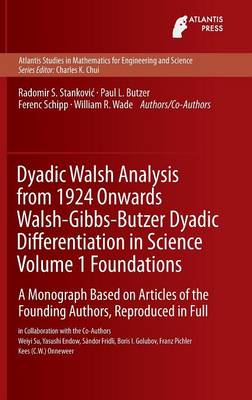Atlantis Studies in Mathematics for Engineering and Science
2 primary works
Book 12
Dyadic (Walsh) analysis emerged as a new research area in applied mathematics and engineering in early seventies within attempts to provide answers to demands from practice related to application of spectral analysis of different classes of signals, including audio, video, sonar, and radar signals. In the meantime, it evolved in a mature mathematical discipline with fundamental results and important features providing basis for various applications. The book will provide fundamentals of the area through reprinting carefully selected earlier publications followed by overview of recent results concerning particular subjects in the area written by experts, most of them being founders of the field, and some of their followers. In this way, this first volume of the two volume book offers a rather complete coverage of the development of dyadic Walsh analysis, and provides a deep insight into its mathematical foundations necessary for consideration of generalizations and applications that are the subject of the second volume. The presented theory is quite sufficient to be a basis for further research in the subject area as well as to be applied in solving certain new problems or improving existing solutions for tasks in the areas which motivated development of the dyadic analysis.
Book 13
Dyadic Walsh Analysis from 1924 Onwards Walsh-Gibbs-Butzer Dyadic Differentiation in Science Volume 2 Extensions and Generalizations
by Radomir Stankovic, Paul Leo Butzer, Ferenc Schipp, William R. Wade, Weiyi Su, Yasushi Endow, Sandor Fridli, Boris I. Golubov, and Franz Pichler
Published 8 January 2016
The second volume of the two volumes book is dedicated to various extensions and generalizations of Dyadic (Walsh) analysis and related applications. Considered are dyadic derivatives on Vilenkin groups and various other Abelian and finite non-Abelian groups. Since some important results were developed in former Soviet Union and China, we provide overviews of former work in these countries. Further, we present translations of three papers that were initially published in Chinese. The presentation continues with chapters written by experts in the area presenting discussions of applications of these results in specific tasks in the area of signal processing and system theory.
Efficient computing of related differential operators on contemporary hardware, including graphics processing units, is also considered, which makes the methods and techniques of dyadic analysis and generalizations computationally feasible.
The volume 2 of the book ends with a chapter presenting open problems pointed out by several experts in the area.
Efficient computing of related differential operators on contemporary hardware, including graphics processing units, is also considered, which makes the methods and techniques of dyadic analysis and generalizations computationally feasible.
The volume 2 of the book ends with a chapter presenting open problems pointed out by several experts in the area.

